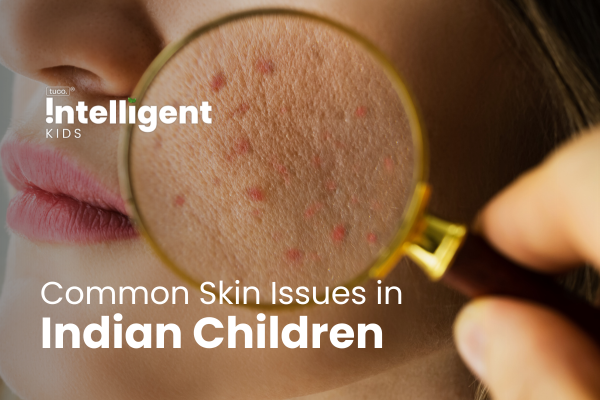
Understanding Common Skin Issues in Indian Children: Causes and Solutions
Share
Introduction:
Skin issues in children are not uncommon, and in a diverse country like India, they can be influenced by various factors ranging from climate to genetics. Understanding these issues is crucial for parents and caregivers to provide appropriate care and seek timely treatment. In this comprehensive guide, we will delve into the common skin issues affecting Indian children, their causes, and effective solutions.
- Eczema:
Eczema, also known as atopic dermatitis, is a chronic inflammatory skin condition characterized by dry, itchy, and inflamed skin. It often appears in early childhood and can persist into adulthood. In Indian children, eczema prevalence is on the rise, with factors such as pollution, climate, and genetic predisposition playing significant roles.
Causes:
- Genetic predisposition: Children with a family history of eczema, asthma, or allergic rhinitis are more likely to develop eczema.
- Environmental factors: India's diverse climate can trigger eczema flare-ups. Dry weather, excessive heat, and pollution can irritate the skin.
- Allergies: Common allergens such as dust mites, pollen, pet dander, and certain foods can exacerbate eczema symptoms.
Solutions:
- Moisturizing: Regular application of emollients helps hydrate the skin and prevent dryness.
- Avoiding triggers: Identify and minimize exposure to triggers such as harsh soaps, synthetic fabrics, and environmental allergens.
- Topical steroids: In severe cases, topical corticosteroids prescribed by a dermatologist can help reduce inflammation and itching.
- Antihistamines: Oral antihistamines may be recommended to alleviate itching and improve sleep quality.
- Skincare routine: Establishing a consistent skincare regimen involving gentle cleansing and moisturizing is essential for managing eczema.
Here's our specially curated range for treating eczema in kids!
- Atopic Dermatitis:
Atopic dermatitis is a more severe form of eczema characterized by intense itching, redness, and scaling of the skin. It often affects the flexural areas such as the elbows and knees and can significantly impact a child's quality of life.
Causes:
- Similar to eczema, atopic dermatitis has a strong genetic component, with family history being a significant risk factor.
- Environmental triggers such as pollen, dust mites, and air pollution can exacerbate symptoms.
- Dietary factors: Certain foods, such as dairy, eggs, nuts, and wheat, may trigger allergic reactions in susceptible individuals.
Solutions:
- Emollients: Regular application of moisturizers helps restore the skin's barrier function and reduce inflammation.
- Topical corticosteroids: Prescription-strength corticosteroid creams or ointments are often necessary to control severe flare-ups.
- Avoiding irritants: Identify and avoid harsh soaps, detergents, and other skincare products that can exacerbate symptoms.
- Antihistamines: Oral antihistamines may provide relief from itching and help improve sleep quality.
- Diet modification: In some cases, eliminating trigger foods from the diet may help reduce the frequency and severity of flare-ups.
- Acne:
Acne is a common skin condition characterized by the formation of pimples, blackheads, and whiteheads, often occurring during adolescence due to hormonal changes. In Indian children, acne prevalence is increasing due to factors such as urbanization, dietary changes, and lifestyle habits.
Causes:
- Hormonal changes: During puberty, increased androgen levels stimulate the sebaceous glands, leading to excess oil production and clogged pores.
- Genetics: Children with a family history of acne are more likely to develop the condition.
- Dietary factors: High-glycemic foods, dairy products, and certain fats have been associated with acne development in some individuals.
Solutions:
- Gentle cleansing: Use a mild cleanser twice daily to remove excess oil, dirt, and impurities from the skin.
- Topical treatments: Over-the-counter topical treatments containing benzoyl peroxide, salicylic acid, or retinoids can help unclog pores and reduce inflammation.
- Avoiding comedogenic products: Choose skincare and cosmetic products labeled as non-comedogenic to prevent pore blockage.
- Healthy diet: Encourage a balanced diet rich in fruits, vegetables, whole grains, and lean proteins while limiting processed foods and sugary snacks.
- Stress management: Stress can exacerbate acne symptoms, so encourage stress-relief activities such as exercise, yoga, or meditation.
- Fungal Infections:
Fungal infections such as ringworm (tinea corporis) and fungal diaper rash (candidiasis) are common skin issues affecting Indian children, especially in hot and humid climates.
Causes:
- Warm and humid environments provide ideal conditions for fungal growth, making children more susceptible to infections.
- Poor hygiene practices, sharing contaminated items, and close contact with infected individuals can facilitate the spread of fungal infections.
- Weakened immune system: Children with underlying health conditions or compromised immune systems are at higher risk of fungal infections.
Solutions:
- Antifungal medications: Topical antifungal creams or ointments are effective in treating most fungal infections. In severe cases, oral antifungal medications may be prescribed.
- Keeping the affected area clean and dry: Regularly wash and dry the skin, paying special attention to areas prone to fungal infections, such as the groin, armpits, and feet.
- Avoiding sharing personal items: Encourage children to avoid sharing towels, clothing, and other personal items to prevent the spread of fungal infections.
- Changing diapers frequently: For infants and toddlers, frequent diaper changes and thorough cleaning of the diaper area can help prevent fungal diaper rash.
- Wearing breathable clothing: Choose loose-fitting, breathable clothing made from natural fabrics such as cotton to reduce sweating and moisture buildup.
Conclusion:
Skin issues are common among Indian children and can have a significant impact on their physical and emotional well-being. By understanding the causes and implementing effective solutions, parents and caregivers can help manage these conditions and improve the overall health and comfort of their children. It is essential to seek guidance from healthcare professionals, especially for persistent or severe skin issues, to ensure appropriate diagnosis and treatment. With proper care and proactive measures, children can enjoy healthy and radiant skin throughout their childhood and beyond.






